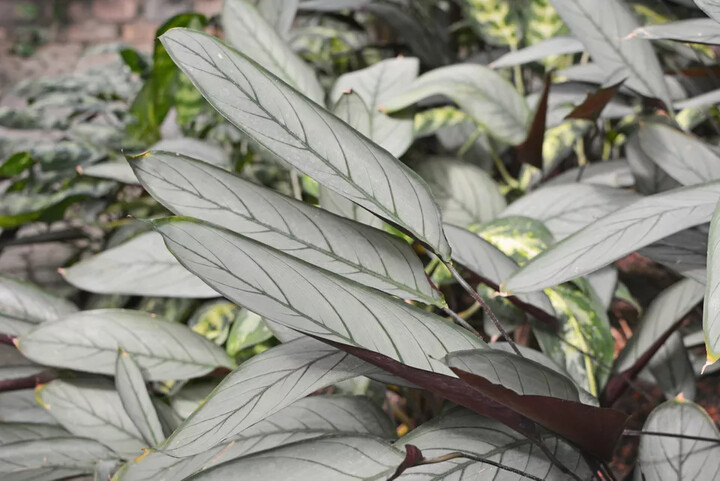
Ctenanthe plants are famous for their striking variegated foliage, and the cultivar Ctenanthe setosa 'Grey Star' is no exception. Related to Calathea and Stromanthe, this is another tropical plant that thrives in a warm, moist, and shady environment.
If you plan to add this species to your houseplant collection, it will be an eye-catching show stopper, but bear in mind it could need a lot of space. The 'Grey Star' can easily reach up to a meter in height if you provide it with the right conditions.
This evergreen, clump-forming, herbaceous perennial has large, thick leaves that feature dark green and silvery-gray stripes on the top. The undersides are also beautiful with their distinctive purple shades. They have setosa in their name as this refers to the hairy leaf stems that are found on this plant.
Although it can produce white blooms when grown in the house, it rarely flowers. This plant is all about the dramatic foliage.
It's kept mostly as a houseplant, but if you can offer Ctenanthe setosa enough humidity and water, it can also make a lush and relatively hardy addition to a shady, tropical-type garden. They can thrive in containers on shady and warm patios, and they will add a striking contrast when grown alongside dense ground-covers.
Readily available in garden stores, Ctenanthe species are often mislabeled, so make sure you do your research and check photos and further information in advance of making a purchase.
Botanical Name :Ctenanthe Setosa 'Grey Star'
Common Name :Never never plant, prayer plant
Plant Type :Perennial, evergreen
Mature Size :Up to 1m. tall
Sun Exposure :Partial shade
Soil Type :Well-drained, moist
Soil pH :Acidic, neutral
Bloom Time :Varies depending on conditions
Flower Color :White, but insignificant
Hardiness Zones :9 - 12, USA
Native Area :Central and South America
Toxicity :Slightly toxic to people and pets
Plant Care
Providing your Ctenanthe setosa 'Grey Star' gets enough shade, warmth and moisture, these plants are pretty low maintenance and easy to care for.
Light
Too much direct sunlight can result in the colors on leaves of the Ctenanthe setosa 'Grey Star' fading. Providing them with a sheltered spot that gets bright but indirect sunlight will ensure the most dramatic display on the foliage. Too much shade can also result in the variegation that these plants are loved for disappearing.
Soil
When grown indoors, a well-drained potting mix with peat moss mixed through will help to ensure the right combination of drainage and moisture retention. It also helps to retain good nutrients, and this is important for a plant that has such large and colorful foliage.
Water
Making sure your Ctenanthe setosa 'Grey Star' gets the right balance in terms of watering is vital for healthy foliage development. During the warm summer growing season, the soil should remain moist but never waterlogged. Too much water and poor drainage can quickly lead to root rot and leaf fungal issues.
Generally watering around twice weekly is to be expected, but you should properly test the soil to make sure it is not already feeling soggy. Some enthusiasts use rainwater even for their Grey Star houseplants.
Once you move into winter, the top of the soil can be allowed to dry slightly, and the frequency of irrigation should drop considerably. Make sure the water used in this colder season is at room temperature as overly cold water will cause problems.
The pot your Ctenanthe setosa 'Grey Star' is kept in should have decent drainage holes in it to prevent water from sitting around the plant's roots.
Temperature and Humidity
All Ctenanthe species need plenty of humidity to thrive. Ideal temperatures are somewhere between 60 and 80 degrees Fahrenheit.
If you always have the AC or heating blasting in every room in your house, then a Ctenanthe setosa 'Grey Star' probably won't be the plant for you. They can't handle dramatic changes in temperatures and don't do well with drafts or dry air.
If you need to up the humidity, you can put the pot of your plant on top of a pebble tray so that the water can gather there without soaking the roots. A humidifier is also a worthwhile investment if you are a tropical houseplant fan.
Fertilizer
Plants with large, lush leaves like the Ctenanthe setosa 'Grey Star' generally benefit from regular feeding with a weak liquid fertilizer during the growing season. In the fall and winter, when the growth slows and stops, feeding can also be halted.
Is Ctenanthe Setosa 'Grey Star' Toxic?
Certain Ctenanthe plants are known to have low levels of toxicity because they can contain chemical compounds like glycosides and alkaloid lycorine. For this reason, it is best to keep them out of the way of dogs or children that are likely to try to ingest the leaves.
Toxicity of Ctenanthe setosa: Symptoms of Poisoning
Ingestion of the leaves could result in vomiting and diarrhea. The mouth and throat could also become swollen, and this could lead to breathing difficulties.
Pruning
The only pruning this plant needs is removing damaged or dying foliage. This tends to happen with the older leaves towards the base of the stem. Trimming these off will direct all the plant's energy into the young growth.
It's also a good idea to periodically wipe down the foliage with a damp cloth. Cleaning away any dust not only gives the leaves a brighter appearance, but it allows them to breathe fully.
Propagating Ctenanthe Setosa 'Grey Star'
Ctenanthe setosa 'Grey Star' is easy to propagate from stem cuttings or offshoots. Make sure any cuttings are around five inches long and that they are taken from a healthy stem with around four leaves.
Potting and Repotting Ctenanthe Setosa 'Grey Star'
Because these plants can grow fast and tall in the right conditions, they will benefit from being repotted every couple of years to ensure they have adequate space.